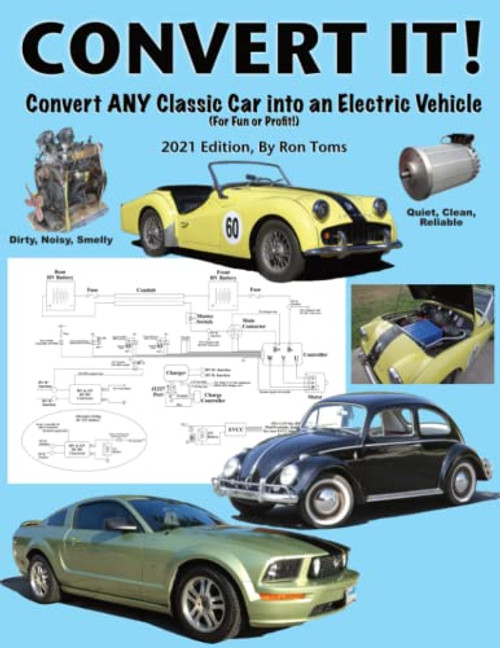Converting a car to electric is a pretty big project, but if you have a good set of tools and mechanical aptitude, you can do it. This book will help you calculate the range and acceleration you'll get with your conversion. It includes a complete detailed schematic diagram, photos, illustrations and an overview of the whole project including a walk through the decisions process, what components are necessary and why you need them, some of the different types of components and how to choose. A page full of useful links for chargers, controllers, battery managers, batteries, motors and other items is included at the end. You will gain the benefit of all my experience working with electrical and mechanical systems, plus many days worth of searching on-line resources and analyzing countless youtube videos. Everything it took to do an actual conversion is distilled into this one comprehensive volume. Here are a few excerpts from the book: The Motor Dont skimp here. Sure, you can save a little money with a lesser motor, but youre going to put a lot of work into this project and youll want the result to be worthwhile. The motor is not your biggest expense, but it is the heart and soul of the performance youll get. The top-of-the-line motors for most DIY projects are currently the Netgain Hyper-9 HV motor or the HPEVS 50/51 models. Budget around $4500 for either one. There are cheaper options: used motors out of forklifts, or an older Nissan Leaf or Tesla motor for example. Used motors are a rapidly moving target, and books like this are notoriously static. They can be a LOT cheaper, but youll have to do your own homework if you choose a used motor. Batteries-- There are a lot of different chemistries for batteries: Lead Acid, Sealed Lead Acid (SLA), Nickel Metal Hydride (NMH), Nickel Cadmium, etc. I could waste a lot of paper and ink on them. but theres no point. In a few years the technology will change anyway. For now, there is only one good choice for DIY EVs. The best chemistry is currently the Lithium Iron Phosphate, or LiFePO4 battery cell. For size, cost, weight and power, LiFePO4 hits the sweet spot better than anything else. They typically come in 3.2 to 3.5 volt cells and a myriad of different sizes and capacities. BMS-- BMS stand for Battery Management System. It gets its own section [in this book] because it works during both the charging and the discharging cycles. It can be a stand-alone system, or integrated with the SoC and Charger. Some people even consider it to be optional. Do you need it? Technically, no. You can charge and discharge your batteries without one. Just like you can technically live on a diet of nothing but sugary sodas and bacon. You just wont be as healthy or live as long as you should have. The same is true for your batteries without the BMS. In fact, not having a good quality BMS will void the warranty on most LiFePO4 batteries. At the time of this writing, the most popular brands are Thunderstruck and Orion...For the record-- The word "overgrown" does not appear anywhere within the text of this book, and it never has.
Convert It!: A simple step-by-step guide for converting any classic car into an electric vehicle.
$19.98 - $22.07
- UPC:
- 9781946767035
- Maximum Purchase:
- 2 units
- Binding:
- Paperback
- Publication Date:
- 3/23/2021
- Author:
- Toms, Ron L
- Language:
- English: Published; English: Original Language; English
- Pages:
- 74











